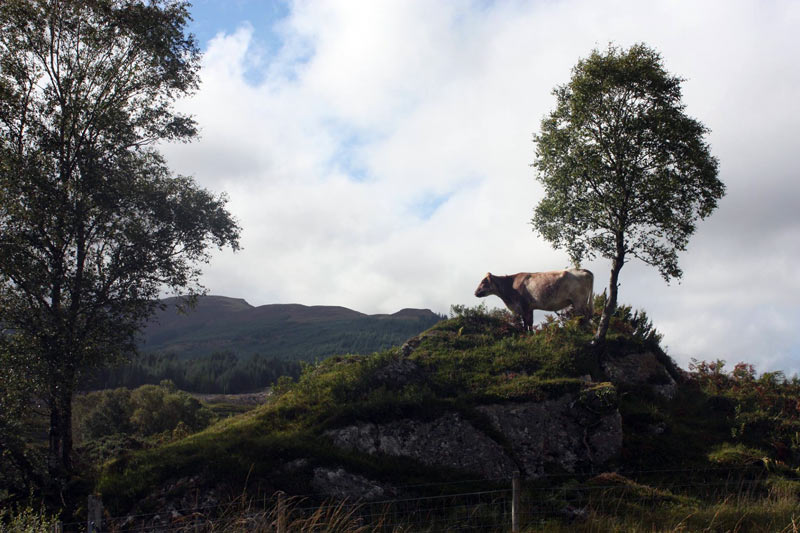Introduction
The nutrition needs for beef animals follows the same principals outlined in the Lakeland Scottish Feeds & Services website entitled “Ruminant Nutrition”.
We recommend that the student should read this first, however those who already have a basic knowledge of ruminant nutrition should find this section of interest and perhaps even useful!
Beef production is obviously split into different priorities. For the dairy cow, the focus is on milk production and pregnancy, this is also true for the suckler cow but on a much lower milk production scale.
The main area of focus for beef is that of growth. The replacement heifers for the suckler herd and the growth of cattle to supply the market for beef.
The growth of the beef for the meat market is made up of many different management systems.
This guide looks at the best ways of managing animals within the variation of techniques that we use in this industry.
UK beef production has its roots firmly embedded in tradition.
The evolution of modern beef farming is based on two systems.
Pure beef breeds and their interbreeding, and pure and crossbred dairy beef.
The following text is not designed to be commercial.
Please visit our website at lakescot.co.uk for information about our beef system feed supplements.
The Beef Breeds
There is also a distinction between Suckler beef, (where the calves are left with their dams (mothers) until they are weaned: and Managed beef (where calves are separated from their dams soon after birth and reared using bought in feeds).
The pure beef breeds broadly fall into three categories:
- Upland native breeds, E.g. Highland cattle, Aberdeen Angus, Galloway, Welsh Black, Luing, etc
- Pastoral native breeds, E.g. Beef Shorthorn, Hereford, North Devon, Sussex, etc
- Continental, E.g. Limousin, Charolais, Belgian Blue, Simmental, etc.
These breeds evolved to suit the local grazing and management conditions.
Generally, the pedigree (pure-bred) stock are retained for breeding stock bulls for cross breeding. The best bulls are retained to further improve the pure-bred blood lines and the rest go for meat.
Commercial suckler cows are generally dairy crosses or pure-bred upland and pastoral breeds which have been served with any of the main beef bred bulls with the objective of producing a dam which is then crossed with another beef breed to produce a commercial carcass for the food chain.
The Dairy Beef Systems
UK dairy breeds include the following breeds:
- Holstein, Friesian, Holstein/Friesian, Ayrshire, South Devon, Jersey, Guernsey, and many other imported breeds like Brown Swiss, Montbeliarde, Norwegian Red, Swedish Red, MRI etc.
These breeds are primarily used for producing milk. The most popular breed being the Holstein/Friesian. Unfortunately, the dairy breeds do not generally have the best conformation for meat production (Montbeliarde being an exception,) so the dairy farmers use mainly continental beef bulls to serve cows that they do not wish to breed dairy heifers from.
They also have a choice as to whether or not to try and rear pure-bred bull calves for beef.
This has become less of an issue when the farmer can use sexed semen for dairy heifer calves.
Pure bred Holstein beef is considered to be unprofitable to rear and attracts a very poor market price in the event that bulls, or steers are reared through to marketing.

Aims & Objectives for Beef Feeding Plans
Rationing the Suckler cow and its beef calf should reflect the need to achieve a target level of productivity. I believe that there are four steps in planning the appropriate feeding regime:
- Agree a target level of performance requirements.
- For Growing & Finishing Cattle.
- Target slaughter, or disposal weight. (Tables 3 a to 3 e)
- Length of feeding period.
- Required daily live weight gain.
- Preferred housing & feeding system to be used.
- Timing of subsidy payments.
- For the Cow.
- Milk yield and stage of pregnancy and Preferred housing & feeding system to be used depending on time of year of calving.
- For Growing & Finishing Cattle.
- Formulate the ration.
- Feed intake levels.
- Energy & protein needs.
- Nutrient content of the feedstuffs to be used.
- Balancing the ration.
- Working out the quantity and cost of the feeds required.
- Flexibility of rationing.
- Will you be able to adjust the diets to match the actual quality of the forage you finish up with? Or can you take advantage of better value for money substitutes?
Diet planning is not usually aimed at grazing cattle, although it should be borne in mind that grazing management is bound to have a big effect on performance, especially when sward quality is deteriorating in the summer droughts, or autumn decline.
Housed cattle are usually the ones to be rationed according to the agreed target level of performance.
Table 1 shows the normal variation of beef cattle groupings commonly found on suckler units.
The variability of the groups can make achieving an ideal diet for all of the animals in a group quite difficult.
There is frequently a need to compromise the ideal balance of the diet and employ a tactic of feeding a forage balancing supplementary feed which gets close enough to the requirements of the average animal in the group and achieving an acceptable compromise in performance.
A typical example of this is to be seen where the earlier finishing heifers are fed the same ration as the later finishing bulls. Care has to be taken that the heifers do not get over fat on the ration.
Table 1: Suckler Systems
| – | – | Spring Calvers | – | – |
| – | – | Heifer Calves | – | Some Bull Calves |
| 1. Spring Calving Hill Cows | ||||
| – | – | Suckled & Grazed | – | Suckled & Creep fed Calves weaned November |
| – | – | Minerals | – | – |
| Wintered on Grower Diet | ||||
| – | – | Out wintered Silage & Minerals |
– | Housed Semi Intensive Silage Grower Diet |
| Spring Grass | ||||
| – | – | – | – | Castrate Bulls 12 Months |
| – | – | Grass & Minerals | Either | Finish Bulls in house 16 months |
| – | – | – | Or | Turn out & Store(Grow)(Steers) |
| – | – | – | – | – |
| Re-House | – | Sell lightweight off grass as store cattle |
– | Sell medium off grass |
| – | Or | Finish at 24 months | Or | Re-house & finish at 24 months |
| – | – | – | – | – |
| Spring Grass | Or | Replacements calving 24, 30, or 36 months |
Or | Grass finish at 24 to 30 months (Prime Beef) |
| – | – | Autumn Calvers | – | – |
| 2. Autumn Calving Hill Cows | ||||
| – | – | Suckled & Trough fed | – | Suckled & Creep fed |
| Turn out | ||||
| – | – | Grass fed & sold October | – | Grass fed & sold October |
| – | – | as light stores | – | as medium stores |
| Re-house | ||||
| – | – | Reared as replacements | – | Steers finished 21 months (April) |
| Turn Out | ||||
| – | – | Sold Heavy Stores | – | Some Steers Grass finished to 24 months |
| – | Or | Reared as replacements | – | – |
